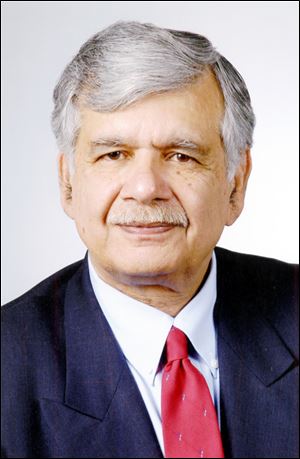
COMMENTARY
Saudi Arabia's bid to modernize country is noble and dangerous
12/4/2017PESHAWAR, Pakistan — Recently Muhammad bin Salman, the crown prince of Saudi Arabia gave a wide-ranging interview to New York Times columnist Tom Friedman. In the interview, the crown prince made it clear that the current government is weary of the chokehold that the Wahhabi imams have had on the country. Politics and political expediency make strange bedfellows.
In order to keep the House of Saud in power, the royal family reached a tacit understanding with the followers of Abdul Wahhab, an 18th century religious reformer who had introduced an austere and harsh interpretation of Islam in the Arabian Peninsula.

Hussain
That meant that the official religion of the kingdom would be the Wahhabi branch of Islam. The Wahhabi imams would be responsible for the interpretation and implementation of religious doctrine, and the royals would be free to rule the country or, as was a common practice among some princes, to indulge in the night life at Monte Carlo and gamble the nights away. It was a convenient arrangement.
But the Wahhabi influence did not remain limited to Saudi Arabia. Riding on the wings of petro dollars, it reached the far corners of the Islamic world, where hundreds and thousands of schools were opened that taught the Wahhabi interpretation of Islam. In this interpretation, sexes were segregated, women were subservient to men, and a husband could divorce his wife simply by uttering the word divorce three times. It forbade the entry of women into the mosques, banned music, theater, and all art that depicts human images.
Until the 1970s, Pakistan was a moderate country and a comfortable accommodation existed between various religions. Now minorities, those Muslims who do not subscribe to their version of Islam, are the targets of Wahhabi-inspired religious fanatics. Anyone and everyone who does not subscribe to their limited and restrictive version of Islam are considered heretics.
Last week, the Pakistani religious parties organized a massive sit-in in the capital of Islamabad and forced the government to abandon changes in a law that confers the death penalty on anyone who insults the persona of Prophet Muhammad.
The law is the legacy of the military ruler Zia ul Haq, who ruled the country in the late 1970s. An orthodox Muslim, he was deeply influenced by the Wahhabi philosophy. The law has been exploited by many unscrupulous individuals to frame members of the minorities.
Despites close ties with successive American governments, the Saudi reputation has suffered after 9/11. Increasingly, the American politicians from both political parties have demanded that the Saudis restrain the export of Wahhabism to other countries. Belatedly, Saudis rulers are themselves realizing that Wahhabism is not what they want in their country.
According to the crown prince, they don’t have to reinterpret Islam. They want to bring back the tolerant Islam that prevailed in Saudi Arabia before the Wahhabi doctrine became pervasive. According to him, Saudi Arabia was a tolerant place where men and women went to cinemas and theaters. However, it is hard to fathom that from the current vantage point.
It would be a step in the right direction. But the Saudi religious hierarchy would be reluctant to yield to the wishes of an aging king and his restless and hyperactive son. But if they are able to bring back the tolerant version of Islam, it will ripple through the entire Sunni world. Saudi Arabia houses two of the most sacred shrines of Islam, and the voices of reason and tolerance emanating from those places would resonate throughout the Muslim world.
But there is an important caveat.
If the religious reforms proposed by the crown prince were meant only to please the American government and some of its allies against the burgeoning influence of Iran in the religion, then it would be a cynical exploitation of religion. With the Saudi-supported civil war in Yemen going nowhere and Iran’s increasing influence in Iraq and Syria, Saudi Arabia feels as if it’s losing its grip in the region.
The undercurrent of distrust between Shia Iran and Sunni Saudi Arabia has its roots in a schism that goes back 1,400 years to the differences on the succession to Prophet Muhammad. Over the centuries, the political differences have turned into religious ones. Wahhabis consider Shias to be heretics and thus outside the circle of Islam. The Wahhabi-inspired Taliban and ISIS have been on a rampage against Shias and other minorities within Islam.
One wonders if Crown Prince Muhammad bin Salman, in his zeal to modernize his country, would also inadvertently divide the Muslim world in two opposing camps of Sunnis and Shias.
S. Amjad Hussain is an emeritus professor of surgery and humanities at the University of Toledo. His column appears every other week in The Blade. Contact him at: aghaji@bex.net.